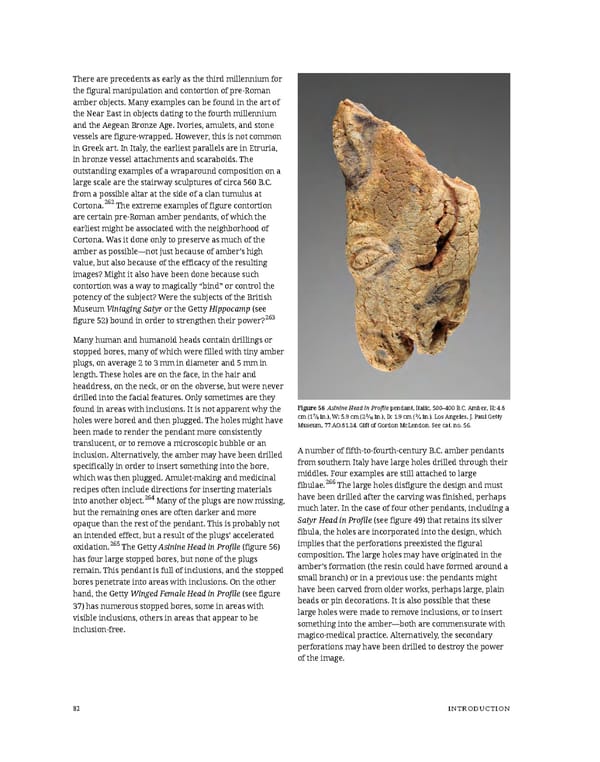There are precedents as early as the third millennium for the figural manipulation and contortion of pre-Roman amber objects. Many examples can be found in the art of the Near East in objects dating to the fourth millennium and the Aegean Bronze Age. Ivories, amulets, and stone vessels are figure-wrapped. However, this is not common in Greek art. In Italy, the earliest parallels are in Etruria, in bronze vessel attachments and scaraboids. The outstanding examples of a wraparound composition on a large scale are the stairway sculptures of circa 560 B.C. from a possible altar at the side of a clan tumulus at Cortona.262 The extreme examples of figure contortion are certain pre-Roman amber pendants, of which the earliest might be associated with the neighborhood of Cortona. Was it done only to preserve as much of the amber as possible—not just because of amber’s high value, but also because of the efficacy of the resulting images? Might it also have been done because such contortion was a way to magically “bind” or control the potency of the subject? Were the subjects of the British MuseumVintaging Satyror the GettyHippocamp(see figure 52) bound in order to strengthen their power?263 Many human and humanoid heads contain drillings or stopped bores, many of which were filled with tiny amber plugs, on average 2 to 3 mm in diameter and 5 mm in length. These holes are on the face, in the hair and headdress, on the neck, or on the obverse, but were never drilled into the facial features. Only sometimes are they found in areas with inclusions. It is not apparent why the Figure 56 Asinine Head in Profile pendant, Italic, 500–400 B.C. Amber, H: 4.8 holes were bored and then plugged. The holes might have cm (17⁄8 in.), W: 5.9 cm (25⁄16 in.), D: 1.9 cm (3⁄4 in.). Los Angeles, J. Paul Getty been made to render the pendant more consistently Museum, 77.AO.81.24. Gift of Gordon McLendon. See cat. no. 56. translucent, or to remove a microscopic bubble or an A number of fifth-to-fourth-century B.C. amber pendants inclusion. Alternatively, the amber may have been drilled from southern Italy have large holes drilled through their specifically in order to insert something into the bore, middles. Four examples are still attached to large which was then plugged. Amulet-making and medicinal fibulae.266 The large holes disfigure the design and must recipes often include directions for inserting materials have been drilled after the carving was finished, perhaps into another object.264 Many of the plugs are now missing, but the remaining ones are often darker and more much later. In the case of four other pendants, including a opaque than the rest of the pendant. This is probably not Satyr Head in Profile (see figure 49) that retains its silver an intended effect, but a result of the plugs’ accelerated fibula, the holes are incorporated into the design, which oxidation.265 The Getty Asinine Head in Profile (figure 56) implies that the perforations preexisted the figural has four large stopped bores, but none of the plugs composition. The large holes may have originated in the remain. This pendant is full of inclusions, and the stopped amber’s formation (the resin could have formed around a bores penetrate into areas with inclusions. On the other small branch) or in a previous use: the pendants might hand, the Getty Winged Female Head in Profile (see figure have been carved from older works, perhaps large, plain 37) has numerous stopped bores, some in areas with beads or pin decorations. It is also possible that these visible inclusions, others in areas that appear to be large holes were made to remove inclusions, or to insert inclusion-free. something into the amber—both are commensurate with magico-medical practice. Alternatively, the secondary perforations may have been drilled to destroy the power of the image. 82 INTRODUCTION
 Ancient Carved Ambers in the J. Paul Getty Museum Page 91 Page 93
Ancient Carved Ambers in the J. Paul Getty Museum Page 91 Page 93